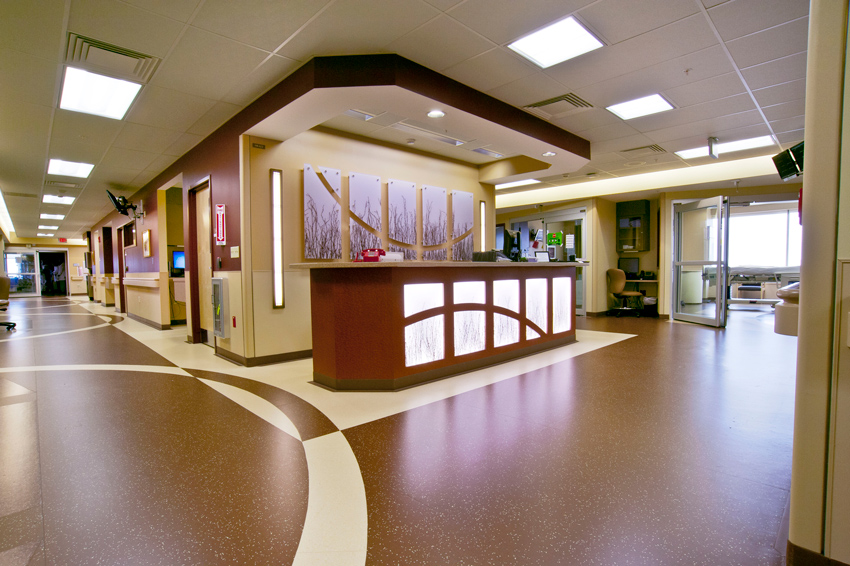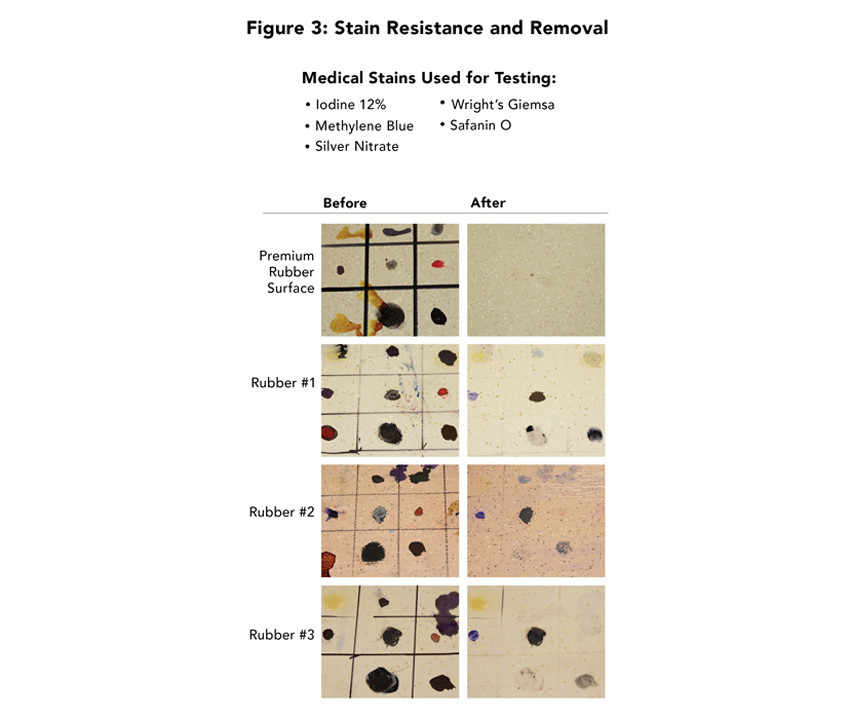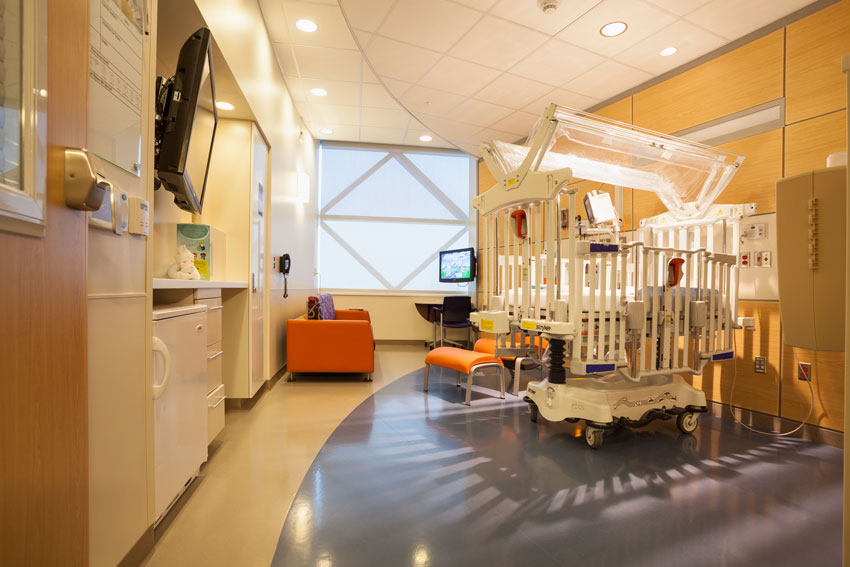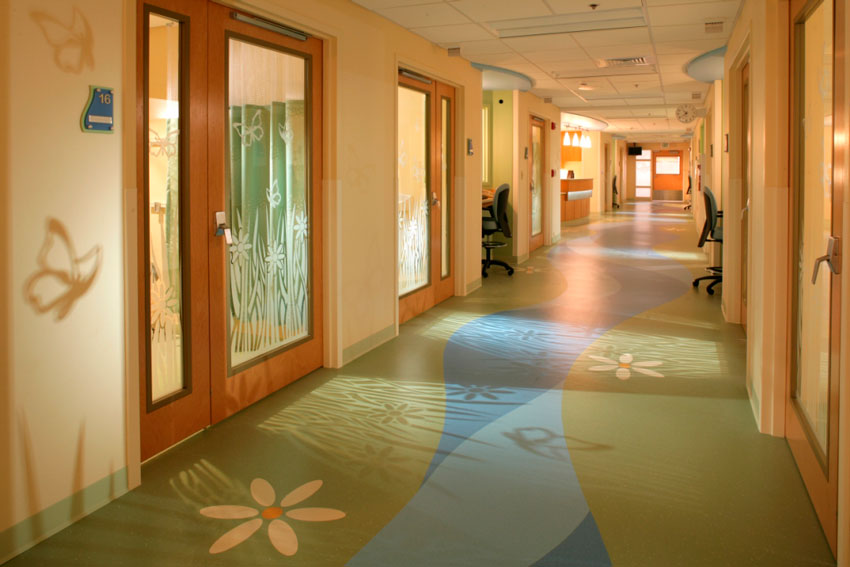Creating Safer Spaces in Healthcare
Clinical Efficiency and Operational Optimization
Flooring that can be efficiently cleaned and disinfected is a fundamental requirement in a healthcare setting when it comes to creating safer spaces. Facilities and environmental service (EVS) teams are tasked to demonstrate value and improve the health, safety, environmental, and operational aspects of the built-environment as it pertains to Cost Quality Outcomes (the CQO Movement is an initiative of the Association for Healthcare Resource and Materials Management: www.ahrmm.org/ahrmm/resources_and_tools/cost_quality_outcomes/index.shtml) .

Photo courtesy of nora systems, Inc.
Roswell Park Cancer Institute, Buffalo, New York
“We wanted to make the ICU as comforting as possible by using materials that limit noise and are softer underfoot,” says Laura Shoemaker, senior planner at Roswell Park Cancer Institute.
Performance in this key area should be evaluated carefully, in order to select rubber flooring products that can be easily and quickly cleaned, require no chemicals and resist soiling, staining, and bacteria. These products contribute to clinical efficiency, the ability to control HAIs, healthy IAQ, and a patient’s perception of a “clean room,” especially when steam cleaned.
In healthcare organizations, flooring represents a significant investment over the life-cycle of the facility, literally underpinning all healthcare delivery activities. To make informed decisions, a comprehensive analysis of both first time and life-cycle costs is necessary. An analysis of VCT, vinyl, carpet, rubber, and linoleum flooring conducted by the Florida Hospital, Office of Design studied the life-cycle costs of those materials over a 15-year period. They found that while VCT is typically the least expensive “first-cost” material, the maintenance costs can be nine to 15 times the installation cost because of the requirement to apply a finish and the associated man-hours to maintain the product. The same study found that rubber flooring had the lowest cost per square foot over the 15 years. Specific rubber flooring products in healthcare do not have a factory applied finish, thus they do not require tedious man hours for waxing and stripping. A cost benefits analysis can carefully evaluate the intrinsic value and support safety and outcomes.
Maintenance is another area where proper product specification improves clinical and operational optimization. An automatic scrubber can clean and buff rubber floors rapidly by applying water to the floor via a scrubbing pad and then squeegeeing the water off the floor, leaving a clean, dry floor in about the same amount of time it takes to mop. This process improves IAQ and eliminates the need for chemicals in cleaning. A leading rubber flooring manufacturer will be introducing a steam cleaning system in early 2016. To clean the floor while an area is occupied gives increased flexibility, reduces disruption to clinical work, improves patient perception, and has a direct impact on HCAHPS scores.
The density, compound composition, and other physical characteristics of some rubber flooring products provides for superior resistance to staining from substances used in healthcare settings. These chemicals can cause permanent, unsightly staining to most other types of flooring, even some rubber flooring products.

Image courtesy of nora systems, Inc.
“We selected a premium rubber flooring product because it was performing so well in the OR. It was even resisting betadine, which is unheard of,” says Aimee Davies, associate at RTKL Associates Inc., about the flooring used at the Texas Heart Institute in Houston, Texas. In the test discussed here, each resilient floor covering received multiple applications, for an extended period of time (exceeding ASTM standards), of chemicals commonly used in medical facilities. Samples were left to set for seven days before being removed, according to the manufacturer’s published recommendation.
One rubber flooring product designed specifically for applications in healthcare was tested and found that it resisted staining to the point that no permanent staining was created from the following medical products (see Figure 3):
• Methylene Blue
• Cristal violet
• Wright giemsa
• Iodine 10 percent
• 3M Dura Prep Surgical Solution and 3M One-Step Patient Prep (0.75 percent iodine)
• Silver nitrate
The staining agent could be easily removed with water and soft abrasion.
Sustainability, IAQ, and Evidence-Based Design
Beyond those already discussed, there are a number of other central topics related to selection, specification, and procurement of rubber flooring product for healthcare. For example, the environmental impact and life-cycle sustainability of flooring are imperative. With limited capital dollars, ROI is a priority. The product material should be completely free of PVC, phthalates, halogens, chlorine, formaldehyde, and carcinogens.

Photo courtesy of nora systems, Inc.
Nemours/Alfred I. duPont Hospital for Children, Wilmington, Delaware
Premium rubber flooring was selected to cover all clinical areas, patient rooms, and corridors in a recent 450,000-square-foot expansion. “I believe the environment really matters to a family because a hospital room represents their home,” says Kay Holbrook, associate administrator at Nemours. “Our patient satisfaction scores have gone up as a result of our new environment. When you walk in the door, you can feel the difference. The flooring has been part of that.”
Some flooring products are manufactured to be more sustainable than others, but rubber flooring in general has environmental advantages over other types of resilient flooring.xiv
Highly durable products with an extended life-cycle and products that have low maintenance requirements to reduce water use, waste water and cleaning chemical use, are preferable.
Indoor air quality is another factor of the built-environment with direct impact on a health and wellness. Flooring selected for healthcare facilities should meet stringent standards for low-VOC emission, including GREENGUARD Gold certification. The minimum requirement should be that the product has been tested and determined compliant with CA 01350; this is the standard used by major green rating systems, including LEED v4. Verification of compliance should come in the form of third-party certification. Both FloorScore and GREENGUARD Gold utilize CA 01350 protocol and are accepted by the major green rating systems.
GREENGUARD Gold certification is a higher-level certification than required by CA 01350 or the major green rating systems. In addition to the 35 chemicals required by CA 01350, it tests for an additional 330 chemicals and includes a TVOC (Total Volatile Organic Compound) measurement.
A study by Perkins+Will compared flooring materials based on environmental and economic costs to understand benefits and drawbacks of choosing certain products.xv Material selection is a crucial component of sustainable design and sustainable selection, where specification decisions are based upon numerous factors. Among a few are material properties, production, cost, and effects on indoor air quality. Prioritizing materials based on their environmental impact is becoming a common practice, with the objective to minimize negative environmental impacts. In order to understand environmental performance of several flooring materials in relation to economic factors, life-cycle assessment (LCA) was conducted for linoleum, vinyl composition tile, nylon carpet tile, composite marble tile, ceramic tile, terrazzo, cork, and rubber flooring.
The study evidenced that there is no single flooring material that has the best environmental performance across all selection criteria. Selection of flooring materials should be based on overall environmental impact, expected lifetime of the material, considerations for maintenance and repair, as well as performance for the particular functional application. Results of the life-cycle assessment indicate that cork, linoleum, and rubber flooring materials perform better than VCT for the majority of environmental impact categories. Although VCT is the least expensive choice, environmental performance should be taken into account as well as its impact on indoor air quality. It is evident that cork, linoleum, and rubber flooring materials should be selected when environmental factors are the primary concern and when both environmental and economic factors are equally weighted. When environmental performance is the driving factor, cork, linoleum, rubber flooring, and terrazzo are comparable.

Photo courtesy of nora systems, Inc.
University of Tennessee Medical Center, Tom and Katherine Black Neonatal Intensive Care Unit, Knoxville, Tennessee
“Noise was such a problem for babies in our previous space,” says Heather King, interior designer of the University of Tennessee Medical Center. “Now, the staff can move around with a low level of noise.”









